
By Chuck Meide, Director of the Lighthouse Archaeological Maritime Program - Lighthouse Archaeological Maritime Program
July 20, 2014
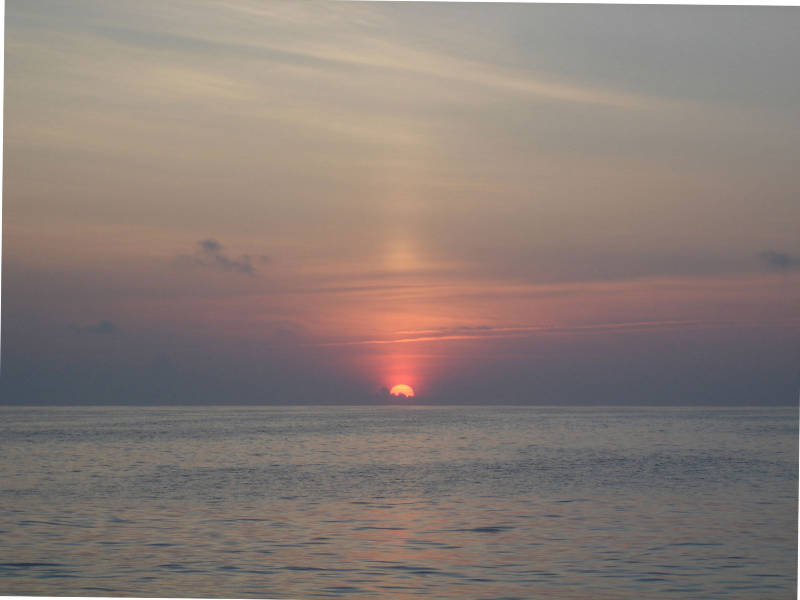
This will be our last sunrise at Canaveral for the next few weeks. It’s a beauty! Image courtesy of Image courtesy of the Search for the Lost French Fleet of 1565 Expedition, NOAA-OER/St. Augustine Lighthouse & Museum. Download larger version (jpg, 146 KB).
Today is the last day of our survey cruise. We only have two lanes left to finish before heading home, so we are confident that we will complete our planned survey and get home safely.
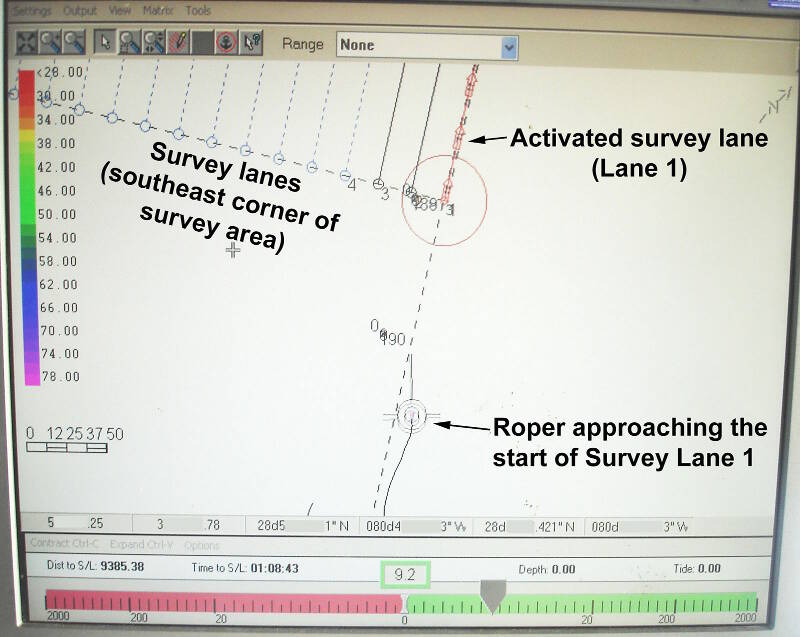
This is a view of our navigational display that the helmsman uses when driving the boat along a survey lane. Image courtesy of Image courtesy of the Search for the Lost French Fleet of 1565 Expedition, NOAA-OER/St. Augustine Lighthouse & Museum. Download larger version (jpg, 278 KB).
Brendan gets up early, before 6:00 am, and when I hear the familiar throb of Roper’s engine, I roll out of my bunk and join him. Soon all the crew is awake and the coffeepot is filling the cabin with its invigorating aroma. It is still dark when we get the towfish back in the water, and the dawn is just providing its first light as we start our penultimate survey lane, Lane 2.
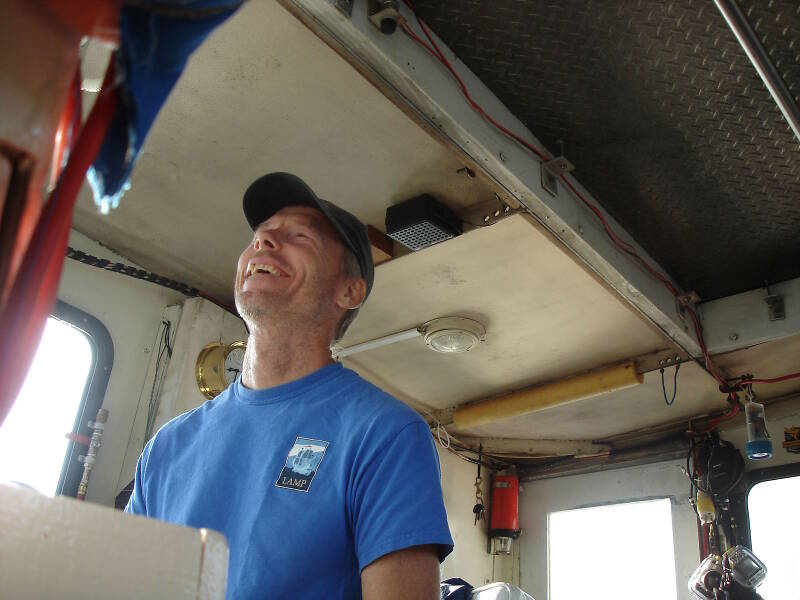
Sam is the boat driver for the final survey lane. He is pretty happy to have completed the survey safely and successfully! Image courtesy of Image courtesy of the Search for the Lost French Fleet of 1565 Expedition, NOAA-OER/St. Augustine Lighthouse & Museum. Download larger version (jpg, 269 KB).
Lane 2 takes about an hour and ten minutes to complete. Then its on to our final survey line, Lane 1!
We run Hypack marine survey software to navigate the search area and to collect and analyze the magnetometer data. The screen above and to the right is what the boat captain sees as he pilots the boat during survey. This photo was recorded just before the start of our final survey lane, which is the furthest offshore lane, or Lane 1. You can see our boat and its course, and the activated lane which it will soon be surveying. The other lanes, already surveyed, extend to the west of Lane 1.

Sam and Brendan pull in the sidescan towfish for the last time. Image courtesy of Image courtesy of the Search for the Lost French Fleet of 1565 Expedition, NOAA-OER/St. Augustine Lighthouse & Museum. Download larger version (jpg, 355 KB).
We finish the final survey lane at 9:07 am. All we have left to do now is to secure the equipment, back up the data, and prepare for the voyage home.
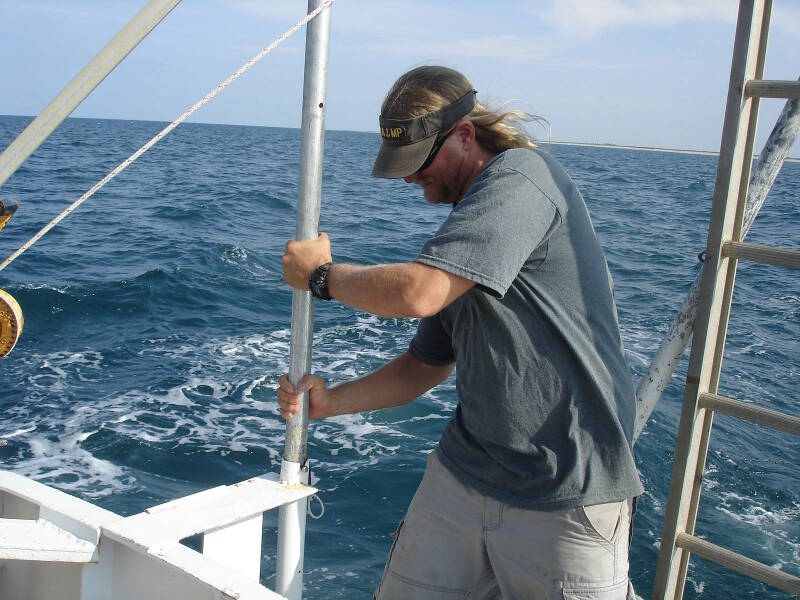
Here I am securing the subbottom profiler at the stern of the boat. Its pole mounting slides up so that we can secure it above water for transit. Image courtesy of Image courtesy of the Search for the Lost French Fleet of 1565 Expedition, NOAA-OER/St. Augustine Lighthouse & Museum. Download larger version (jpg, 411 KB).
The seas are calm, and the crew is practiced, so it is easy to get all of our instruments out of the water and secured on deck in a matter of minutes. I included the picture of me to the right since there are so few pictures of me, since I tend to be the one with the camera recording the day’s activities.
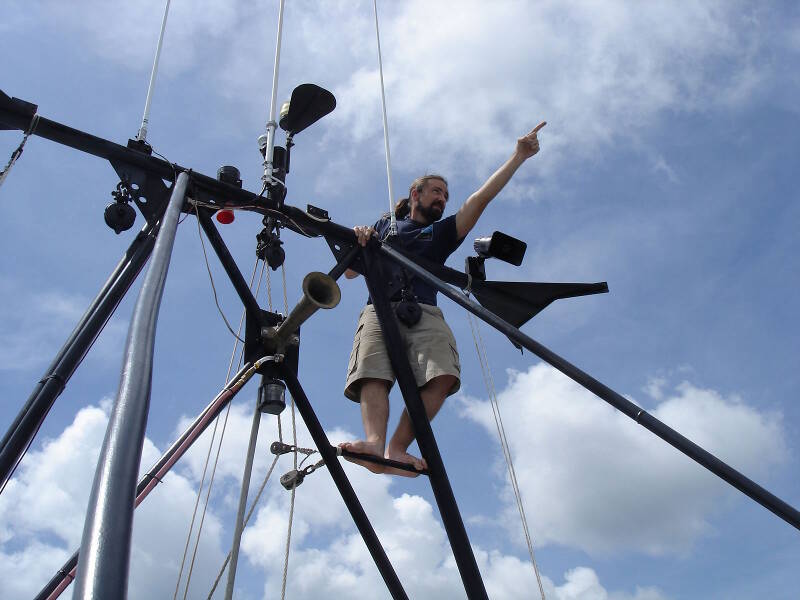
Brian has climbed to the top of the masthead to point the way home! Image courtesy of Image courtesy of the Search for the Lost French Fleet of 1565 Expedition, NOAA-OER/St. Augustine Lighthouse & Museum. Download larger version (jpg, 233 KB).
We depart the survey area for home at 9:15 am. We have completed 35 survey lanes, or 175 nautical miles of survey, with all remote sensing devices operational and recording for the duration of the project.
The only lanes we did not survey were those that were simply too shallow to access in the Roper. We finished all of our planned lanes even though we lost well over a full day’s worth of survey due to technical problems and weather conditions. We know we have some magnetic anomalies, as we have observed them in real time, and there is a very good chance that there are further magnetic signatures, or sonar contacts, that will turn up after data analysis that might also promise to be potential shipwreck sites.
By all measures, we have had a successful project, and we are all excited to go through the data over the next two weeks in order to better understand what exactly we may have found.

As the Roper heads home for St. Augustine, she weathers a late afternoon Florida thunderstorm, providing the boat and her crew with a nice freshwater rinse and cooler temperatures. Image courtesy of Image courtesy of the Search for the Lost French Fleet of 1565 Expedition, NOAA-OER/St. Augustine Lighthouse & Museum. Download larger version (jpg, 193 KB).
The transit home takes the rest of the day. By noon we are abeam Daytona Beach, and we keep chugging along to the north. As the afternoon progresses, we enjoy watching the storm clouds on the horizon and ride through a thunderstorm as well on the way home, but its not too powerful, nothing that Roper or the crew can’t handle. In fact it is very pleasant, as the rain cools down the afternoon temperatures nicely. At 5:13 the St. Augustine Lighthouse is in sight! Like the mariners of old, it is comforting to see this symbol of home and safe harbor.
A LAMP tradition is to hoist a broom from the masthead after a successful endeavor at sea. This is a longstanding British Royal Navy practice, to signify a “clean sweep” after a victory at sea. Needless to say, our broom is hoisted for all to see as we enter the St. Augustine Inlet.
By 7:35 pm, we have unloaded the boat and she is safely moored at her overnight dock on Salt Run. We emerge from the boat exhausted but exhilarated, and looking forward to jumping headfirst into our body of data and our return to the site of the shipwrecks of the lost French Fleet of 1565.